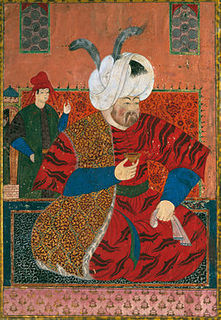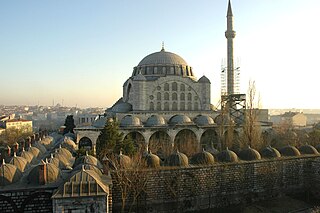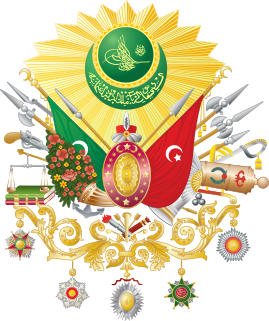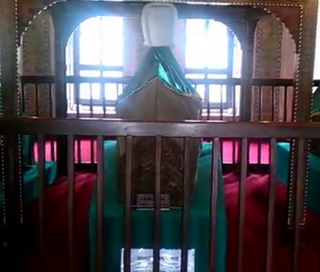
Bayezid II was the eldest son and successor of Mehmed II, ruling as Sultan of the Ottoman Empire from 1481 to 1512. During his reign, Bayezid II consolidated the Ottoman Empire and thwarted a Safavid rebellion soon before abdicating his throne to his son, Selim I. He is most notable for evacuating Sephardi Jews from Spain after the proclamation of the Alhambra Decree, and resettling them throughout Ottoman lands, especially in Salonica.

Murad III was the Sultan of the Ottoman Empire from 1574 until his death in 1595.

Selim II, also known as Sarı Selim or Sarhoş Selim, was the Sultan of the Ottoman Empire from 1566 until his death in 1574. He was a son of Suleiman the Magnificent and his wife Hurrem Sultan. Selim had been an unlikely candidate for the throne until his brother Mehmed died of smallpox, his half-brother Mustafa was strangled to death by the order of his father, his brother Cihangir died of grief at the news of this latter execution, and his brother Bayezid was killed on the order of his father after a rebellion against Selim.

Hurrem Sultan, also known as Roxelana, was the chief consort and wife of the Ottoman sultan Suleiman the Magnificent. She became one of the most powerful and influential women in Ottoman history as well as a prominent and controversial figure during the era known as the Sultanate of Women.

The Süleymaniye Mosque is an Ottoman imperial mosque located on the Third Hill of Istanbul, Turkey. The mosque was commissioned by Suleiman the Magnificent and designed by the imperial architect Mimar Sinan. An inscription specifies the foundation date as 1550 and the inauguration date as 1557. Behind the qibla wall of the mosque is an enclosure containing the separate octagonal mausoleums of Suleiman the Magnificent and that of his wife Hurrem Sultan (Roxelana). For 462 years, the Süleymaniye Mosque was the largest mosque in the city, until it was surpassed by the Çamlıca Mosque in 2019. The Süleymaniye Mosque is one of the best-known sights of Istanbul, and from its location on the Third Hill, it commands an extensive view of the city around the Golden Horn.
Nurbanu Sultan was Haseki Sultan of the Ottoman Empire as the principal consort of Sultan Selim II, his legal wife, as well as Valide Sultan as the mother of Sultan Murad III. She was one of the most prominent figures during the time of the Sultanate of Women. Conflicting theories ascribe her a Venetian, Jewish or Greek origin. Her birth name may have been Cecilia Venier-Baffo, Rachel or Kalē Kartanou.

A külliye is a complex of buildings associated with Turkish architecture centered on a mosque and managed within a single institution, often based on a waqf and composed of a madrasa, a Dar al-Shifa ("clinic"), kitchens, bakery, Turkish bath, other buildings for various charitable services for the community and further annexes. The term is derived from the Arabic word kull "all".

The Şehzade Mosque is a 16th-century Ottoman imperial mosque located in the district of Fatih, on the third hill of Istanbul, Turkey. It was commissioned by Suleiman the Magnificent as a memorial to his son Şehzade Mehmed who died in 1543. It is sometimes referred to as the "Prince's Mosque" in English. In a June 2016 attack, the windows of the mosque were shattered.

The Mihrimah Sultan Mosque is a 16th-century Ottoman mosque located in the Edirnekapı neighborhood near the Byzantine land walls of Istanbul, Turkey. It was commissioned by Mihrimah Sultan, the daughter of Suleiman the Magnificent and designed by the chief imperial architect Mimar Sinan. Sited on the peak of the Sixth Hill near the highest point of the city, the mosque is a prominent landmark in Istanbul.

Sokollu Mehmed Pasha Mosque is a 16th-century Ottoman mosque in the Kadırga neighborhood in Fatih district, Istanbul, Turkey. It was commissioned jointly by the grand vizier Sokollu Mehmed Pasha and his wife İsmihan Sultan. It was designed by the imperial architect Mimar Sinan and completed in 1571/2. The mosque is noted for the fine quality of the Iznik tiles that decorate the interior walls.

Gülbahar Hatun, also known as Ayşe Hatun was a consort of Sultan Bayezid II and the mother of Sultan Selim I of the Ottoman Empire and the grandmother of Sultan Suleiman the Magnificent.

The following outline is provided as an overview of and topical guide to the Ottoman Empire:
The Ottoman Empire (1299–1922) is a historical Muslim empire, also known by its contemporaries as the Turkish Empire or Turkey after the principal ethnic group. At its zenith in the second half of the 16th century it controlled Southeast Europe, Southwest Asia and North Africa. Below are the links to articles about the Ottoman Empire.

Mihrimah Sultan was an Ottoman princess, the daughter of Ottoman Sultan Suleiman the Magnificent and his wife, Hurrem Sultan. She was the most powerful imperial princess in Ottoman history and one of the prominent figures during the Sultanate of Women.

Şehzade Ahmet was an Ottoman prince who fought to gain the throne of the Ottoman Empire in 1512–13.

Şehzade Bayezid was an Ottoman prince as the son of Sultan Suleiman the Magnificent and Hurrem Sultan. After the execution of Şehzade Mustafa in 1553, Bayezid became the popular heir among the army. Throughout the 1550s, when Suleiman was already in his 60s, a protracted competition for the throne between Bayezid and his brother Selim became evident. Bayezid had fallen into disfavor with his father – who was angered by Bayezid's disobedience stemming from around the same years – as opposed to Selim. After being defeated in a battle near Konya in 1559 by Selim and Sokullu Mehmet Pasha, he fled to the neighbouring Safavid Empire, where he was lavishly received by Tahmasp I. However, in 1561, on the continuous insistence of the Sultan throughout his son's exile, and after several large payments, Tahmasp allowed Bayezid to be executed by agents of his own father.

Şehzade Mehmed was an Ottoman prince (şehzade), the son of Sultan Suleiman the Magnificent and his consort Hurrem Sultan.
Gevherhan Sultan was an Ottoman princess, the daughter of Sultan Selim II. She was the granddaughter of Suleiman the Magnificent and Hürrem Sultan, sister of Sultan Murad III and aunt of Sultan Mehmed III.






















